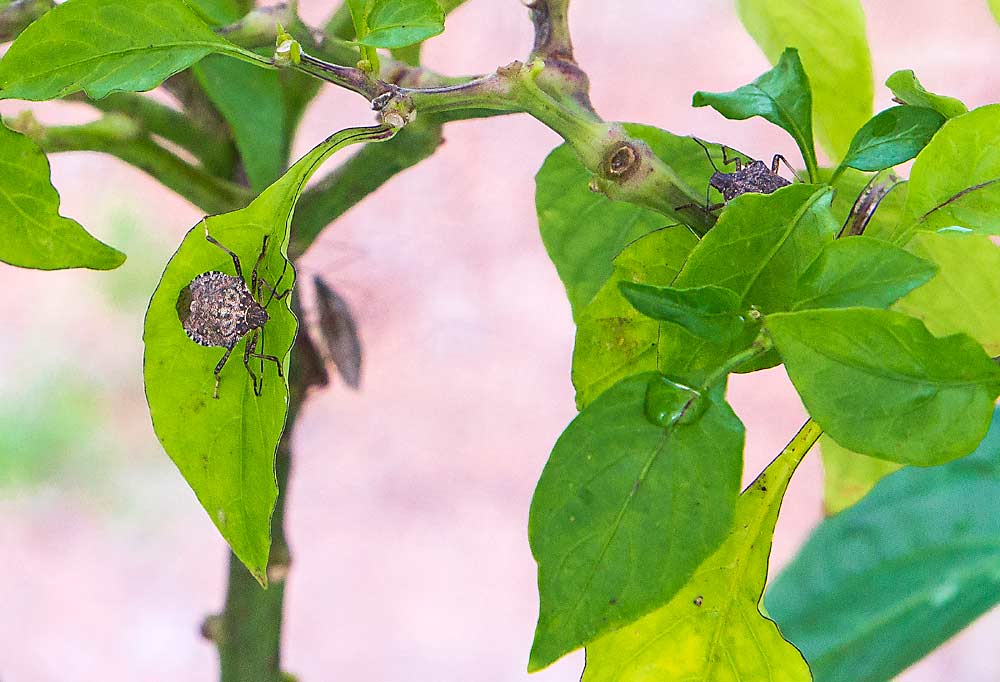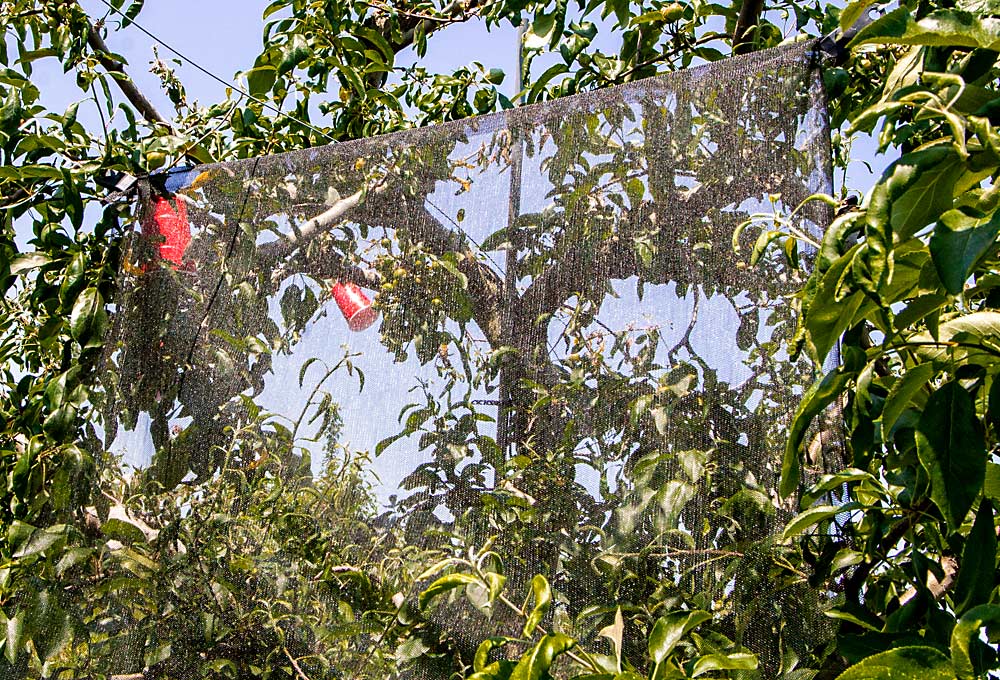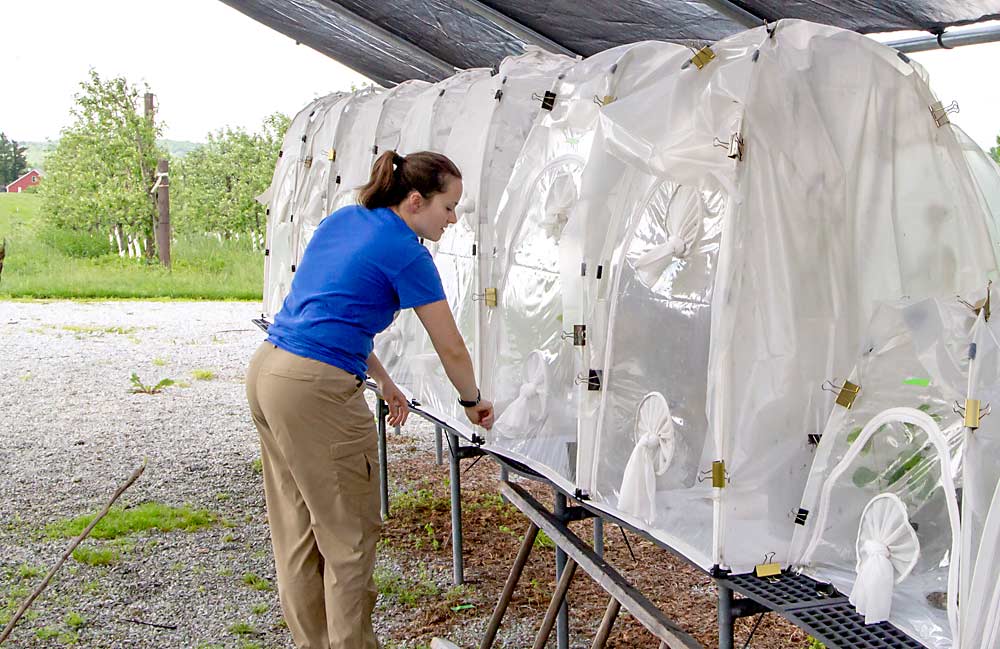
No one wants brown marmorated stink bugs, except researchers raising colonies for research projects on everything from how far they can fly to the effectiveness of egg parasitism. Now, nearly 10 years after the first devastating outbreak, better understanding of the pest’s behavior and ecology has helped Mid-Atlantic growers control it with fewer sprays and more peace of mind. (Kate Prengaman/Good Fruit Grower)
Almost a decade after the first brown marmorated stink bug outbreak cost Mid-Atlantic apple growers millions, the pest is no longer inducing panic, thanks to advancements in targeted management for orchardists.
Armed with border sprays, lures, traps and threshold-based management, growers can reliably protect their crops.
Now, researchers have moved toward new efforts to regain integrated pest management in the orchard ecosystems, with attract-and-kill strategies to minimize insecticide sprays and understand how best to use the biocontrol wasp that followed BMSB here from Asia.
It took a massive effort by researchers across the U.S. to get a handle on the initial BMSB invaders.
“At first, we didn’t even know what to spray, so that was the first stage,” said Tracy Leskey, entomologist with the U.S. Department of Agriculture, who leads the region-wide research program for BMSB from the Agricultural Research Service Station in Kearneysville, West Virginia. “Now, we are learning about their biology, behavior and ecology to manage them more sustainably, and the final stage is the biocontrol to manage them across the landscape.”
Growers in the region say they know how to manage the pest now, but are eager for new tools, such as attract-and-kill strategies and biocontrols, to keep the population low and prevent damaging outbreaks.
“Growers are not scared that stink bugs will surprise them, now that we understand them so much better and can use monitoring,” said Greg Krawczyk, entomologist at Pennsylvania State University’s Fruit Research and Extension Center in Adams County. “But we really messed up the whole integrated pest management system we had before.”
Secondary pests, such as woolly apple aphid, scales, mites and aphids, boomed after natural-enemy populations were wiped out by the use of broad-spectrum chemistry, he said.
“Before the stink bugs, we used mating disruption, selective chemicals and biological controls. Growers didn’t need to spray more than four times after bloom,” Krawczyk said. “Then BMSB happened and we went from four to 10, 12, 14 sprays.”
Now, nearly 10 years later, “the system is getting back toward normal,” and growers spray insecticides about six times a year, including twice for BMSB if needed, he said.

Freshly laid brown marmorated stink bug eggs are key to research efforts to study egg parasitism and the potential for biocontrol. (Kate Prengaman/Good Fruit Grower)
Traps and thresholds
Monitoring traps — now sticky cards on a simple stake have replaced the unwieldy black pyramid traps — baited with improved lures can reliably capture adult and nymph BMSB, even at low population levels. Using these tools prevents the need to spray prophylactically.
Because BMSB feeds on so many crops and native plants, its unpredictability played a large role in the initial panic. “It didn’t happen everywhere,” Krawczyk said. “It’s more random, but people were so scared of BMSB in 2011, 2012 and their options were to spray and have fruit to sell, or go out of business.”
A few years on, that began to change. Entomologists across the region tested over 60 insecticides, found about 10 that were effective, and began to recommend to growers how best to select products.
Then, Leskey and her team demonstrated that for apple growers, basing a spray program on a trap capture of 10 adults can maintain good control of the pest, preventing crop injury while reducing sprays. They recommend two sprays of an effective insecticide, seven days apart. Similar thresholds are in development for peaches.
Krawczyk agrees that threshold-based management is key but recommends that growers look for nymphs instead of adults. “In my opinion, the presence of the nymphs is the major factor depending on whether they will spray or not,” he said.
Adults travel so much that the presence of a few adults is not a good indicator, he continued, but flightless nymphs means eggs have hatched in your orchard and the nymphs will be feeding for the next five or six weeks.
Attract-and-kill strategies could lower the need for insecticide covers even further and help growers rebuild the populations of natural enemies necessary to keep secondary pests in check.
In Pennsylvania, Krawczyk combines aggregation lures with insecticide-infused nets hanging from poles or deer fences at the edge of an orchard. The technique shows promise in his research, killing hundreds and hundreds of bugs, but the nets are not yet registered for this use.

Placing aggregation lures and insecticide-infused netting in the same tree may be an effective attract-and-kill approach for controlling brown marmorated stink bugs, while using fewer sprays. USDA entomologist Tracy Leskey is testing the technique and said that using a trap tree, rather than a stand-alone net and lure, increases retention of the pest and, therefore, increases exposure to the pesticide. (Kate Prengaman/Good Fruit Grower)
For her part, Leskey’s attract-and-kill trials focus on creating trap trees, hanging the insecticidal nets in baited trees.
“Behaviorally, having that aggregation pheromone associated with the host plant, we see the attraction and retention is greater,” she said. Outside the orchard, “they’ll show up, but they may not stay long enough to take a lethal dose” from contact with the net.
Once registered, with such trap trees spaced along the edge of the block or perhaps stand-alone nets baited with lures and plant volatiles, growers might not need to spray at all.
“You could put this up and forget about it, like mating disruption,” Leskey said. “Then you use a monitoring trap to make sure you are not getting penetration into the center of the block; and if you still do, that triggers a monitoring spray.”
Biocontrol
With such a wide host range and populations in unmanaged woodlands, BMSB will continue to pose a threat to farms without landscape-wide biological control. That’s why hopes run high that the samurai wasp — a parasitoid wasp that targets the brown marmorated stink bug, specifically — will live up to its name and help to keep the pest in check as populations grow.
Trissolcus japonicus has now been found in 10 states, including Pennsylvania, Maryland, New Jersey, Virginia, New York, Oregon and Washington, and researchers have begun to rear them for targeted releases.
In New Jersey, researchers even found wasp activity in a conventional peach orchard using a border spray program, Rutgers University entomologist Anne Nielson reported in a talk at the Great Lakes Fruit, Vegetable and Farm Market Expo in Grand Rapids, Michigan, in December.
Studying stink bugs and their parasitoids requires rearing colonies to produce eggs.

Graduate student Hillary Peterson tends to the colony of brown marmorated stink bugs at Penn State University’s Fruit Research and Extension Center in Biglerville in May 2018. (Kate Prengaman/Good Fruit Grower)
At Penn State’s Fruit Research and Extension Center, graduate student Hillary Peterson said that finding the bugs for her BMSB colony was easy — people collect the nuisance pests from their houses and bring them to the center — but she also had to figure out a diet to keep them alive and laying eggs.
Protein turned out to be key, along with variety for the voracious pests, so she gives them soybeans, peppers and bird seed, along with fresh leaves from a variety of greenhouse plants.
At the USDA-ARS station in Kearneysville, the colony of stink bugs feeding on the common houseplant Peperomia and tiny trees-of-heaven, along with seeds and veggies, lay between 20 and 60 egg masses a day, Leskey said, which researchers will use to rear T. japonicus for release and research.
There’s still much to learn about the wasp: how to release them, where and when, how far they can travel, the conditions they need to establish populations, and how best to mark and recapture them for research, she added, and researchers across the country are working together to find out. •
—by Kate Prengaman
Related:
—Native natural enemies
—Put a ghost in your orchard to keep away BMSB
—Wasps released to eat stink bug eggs






Leave A Comment